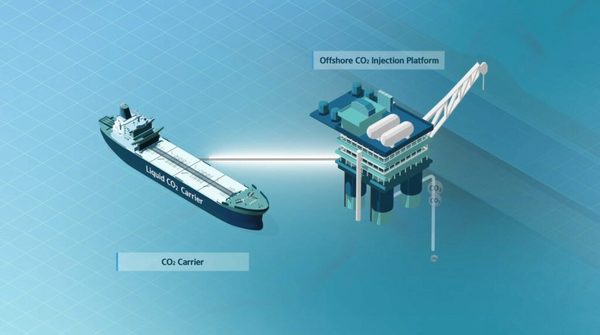World's largest' liquefied CO2 carrier being developed to meet rising CCS demand
The American Bureau of Shipping (ABS), Hyundai Heavy Industries (HHI), and the Marshall Islands' Maritime Administrator have partnered to develop what they say would become the world's largest liquefied carbon dioxide (LCO2) carrier to date.
 PHOTO: Model of Hyundai Heavy Industries' carbon dioxide injection platform. KSOE
PHOTO: Model of Hyundai Heavy Industries' carbon dioxide injection platform. KSOE
The LCO2 carrier will have 74,000 cbm capacity, which would be bigger than recent 40,000 cbm capacity carrier design developed by HHI and its parent company Korea Shipbuilding & Offshore Engineering (KSOE) and approved by shipping classification society DNV last September.
This announcement follows a joint project between ABS and HHI to advance carbon capture technologies.
Last month, ABS approved an offshore carbon dioxide injection platform developed by HHI. Carbon dioxide will be captured on land, liquified at high pressure and transported to the platform via a LCO2 carrier or pipeline. The aim is to store 400,000 mt/year of carbon dioxide under South Korea’s East Sea gas field from 2025.
After making progress in developing this carbon storage platform, HHI and ABS are working to develop LCO2 carriers to scale the carbon capture and storage (CCS) economy, says ABS chief executive Christopher J. Wiernicki.
The challenge has been to build vessels with a large carrying capacity to scale LCO2 shipping to meet rising demand for CCS – both to decarbonise industrial and fuel production industries and to ship captured CO2 to plants producing synthetic fuels with CO2 as one of the inputs.
LCO2 carriers have been used by the food and beverage industry for years, but at much smaller scale. The typical LCO2 carrying capacity of these vessels has been 800-1,000 cbm, according to a 2021 study. Its authors argued that one of the key barriers to scaling CCS globally is limited scale of LCO2 shipping.
Japanese Mitsubishi Shipbuilding said in February it would build the world’s first LCO2 carrier specifically made to transport LCO2 for CCS, which is still at an early stage of development.
Shipping firm Mitsui O.S.K Lines (MOL) completed a study on a concept design for a 50,000 cbm capacity combined LCO2 and ammonia carrier in November last year. The study followed an investment into Larvik Shipping, which has been developing and converting dry bulk carriers to LCO2 tankers for over three decades.
Both Mitsubishi Shipbuilding and MOL’s LCO2 carrier developments are part of the Japanese New Energy and Industrial Technology Development Organisation project. The project runs from 2021 to 2026 and aims to scale LCO2 carrying capacity.





